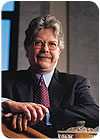
Here are a few factoids and points that may be worth pondering during your next brainstorming session in the marketing department.
- Spend less time listening to what consumers say and more time watching what they do. If you don't believe me, ask Harry Balzer. At the Institute of Food Technologists' Expo in June, he explained: When it comes to food choices, whatever consumers say, their eating habits reveal something very different.
- A trip through the Fancy Food Show in New York City a couple of months ago suggested that people are looking for things sweet and savory - part sweet and part sassy. This took me back to an old cheese maker's recipe: A scoop or two of vanilla ice cream topped with crumbled blue cheese. Try it, you'll like it.
- Nearly 10 million people drive more than an hour each day just to get to work, prompting Chrysler Motors to offer an optional refrigerated glove box in the new Dodge Caliber. This certainly adds a new twist to dashboard dining. There's research suggesting that, on average, Americans eat almost a meal a week in their cars.
- It sounds to me like more drive-up windows should be popping up at service stations, convenience stores, and traditional grocery retailers. Sheetz, a C-store, has touch screens at the gas pumps so folks can order a meal and grab it at the pick-up window after feeding the car.
- How about creating more refrigerated, dairy-based meals? How about positioning some products already on the market as meals. Please be bold enough to call them meals; don't call them meal replacements.
- About $150 million was spent advertising beverage (fluid) milk during 2005. Sales, on a volume basis, continued a decade-long slide lower. About $125 million was committed to generic efforts; less than $25 million was spent on branded advertising. Milk advertising was equal to about two-and-a-half cents per gallon; soft drink marketers spent a nickel a gallon and fruit-based beverage peddlers spent a dime.

Value-added milk, like milk made without rBST, accounts for 11% of overall volume, but 17% of the revenue.
- Cheese advertising expenditures totaled about $160 million during 2005. Generic spending totaled just over $60 million; branding advertising, not quite $100 million. Sales were up 1.5% versus the previous year.
- Relatively speaking (no pun intended), here in the USA we have more grandparents and fewer grandchildren. That is, the percent of the population under six years of age is shrinking and the percent over 60 is increasing. Shouldn't we be making dairy beverages and dairy foods for Grandpa and Grandma? Please, don't call them that.
- The dairy business continues to treat most milk and manufactured products like commodities, but the real action is in value-added and specialty foods and beverages. For example, Beverage Marketing Corporation tells us that: "Standard" milk accounted for 89% of the beverage milk volume and 83% of the revenue in 2004. At best, sales for this segment were flat.
Value-added milks, which include organic, rBST free, fortified, lactose-free and flavored, are just 11% of the volume, but 17% of the revenue, and showing strong growth. If my math is correct, value-added milks are selling, on average, for about 66% more than standard milks. -
Specialty cheesemakers have a grand record of creating and marketing a host of value-added cheeses; products that have created a halo for the entire category. Ahh, the power of cheese! And cheese makers in this country have been winning blue ribbons for years in the World Competition hosted by the Wisconsin Cheese Makers Association. More recently, U.S. cheesemakers have been bringing ribbons home from another World Competition held in London.
While commodity cheeses sell for four or five bucks a pounds, these specialty items cross the scale at $10 and $15 a pound.
I'd recommend adding a few of your own random thoughts; then launching a productive discussion.
- Cheese advertising expenditures totaled about $160 million during 2005. Generic spending totaled just over $60 million; branding advertising, not quite $100 million. Sales were up 1.5% versus the previous year.
- Relatively speaking (no pun intended), here in the USA we have more grandparents and fewer grandchildren. That is, the percent of the population under six years of age is shrinking and the percent over 60 is increasing. Shouldn't we be making dairy beverages and dairy foods for Grandpa and Grandma? Please, don't call them that.
- The dairy business continues to treat most milk and manufactured products like commodities, but the real action is in value-added and specialty foods and beverages. For example, Beverage Marketing Corporation tells us that: "Standard" milk accounted for 89% of the beverage milk volume and 83% of the revenue in 2004. At best, sales for this segment were flat.
Value-added milks, which include organic, rBST free, fortified, lactose-free and flavored, are just 11% of the volume, but 17% of the revenue, and showing strong growth. If my math is correct, value-added milks are selling, on average, for about 66% more than standard milks. -
Specialty cheesemakers have a grand record of creating and marketing a host of value-added cheeses; products that have created a halo for the entire category. Ahh, the power of cheese! And cheese makers in this country have been winning blue ribbons for years in the World Competition hosted by the Wisconsin Cheese Makers Association. More recently, U.S. cheesemakers have been bringing ribbons home from another World Competition held in London.
While commodity cheeses sell for four or five bucks a pounds, these specialty items cross the scale at $10 and $15 a pound.
I'd recommend adding a few of your own random thoughts; then launching a productive discussion.